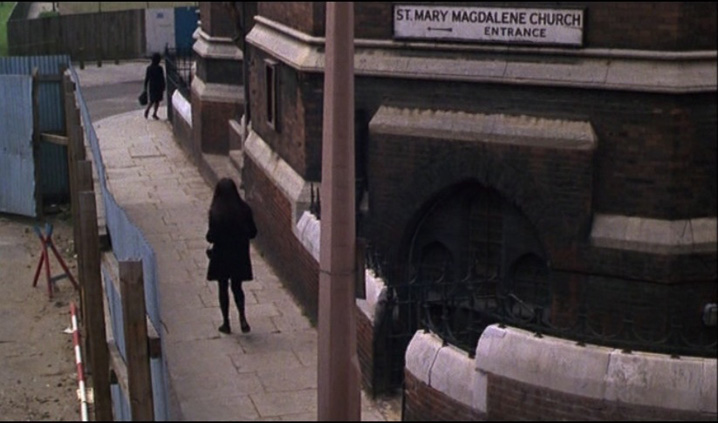
With 1967's Accident, American-born director Joseph Losey, who had been living and working in Europe since the early '50s after fleeing the Hollywood blacklist, seemed to solidify his reputation as a major director (pace those critical outliers the MacMahonists. who had dubbed him one of their "four aces"—the others being Preminger, Walsh and Lang, well prior to this point). The film was followed by Tom Milne's book-length interview with the director, Losey on Losey; in the introduction to that text, Milne cites Gilles Jacob's observation that Losey's work represents "a dress rehearsal for an ideal film which never materializes" and goes on to assert that "to my mind that ideal film has now materialized in Accident." Indeed, to this day Accident remains one of Losey's very best; a startling, often nerve-racking cinematic eddy of perfectly calibrated emotional effects. (It was the second of Losey's three collaborations with screenwriter Harold Pinter, who adapted Nicholas Mosley's novel.)
One might have assumed at the time that Losey was thus perfectly positioned to bound from strength to strength. But his could not be called a fluent career. Late in the Milne interview, he alludes to working with Tennessee Williams; "Well, that sounds promising," one might have said at the time. However, the result turned out to be the Richard Burton and Elizabeth Taylor-starring Boom!, an multi-leveled disaster that John Waters has called "the best failed art film ever." It is not available on DVD. However, its followup Secret Ceremony, starring Taylor but not Burton (and despite that, some wag at the time tarred Losey as "the house director for the Burton-Taylors") is, and it's a fascinating mish-mash.
The first twenty minutes are kind of remarkable. They're almost entirely dialogue free, and depict a little cat-and-mouse game between Taylor's character Leonora (who we later find out is a prostitute) and the rather gaga girl Cenci (Mia Farrow, unnervingly Paltrowesque avant le lettre). Cenci sees Leonora on a bus and gets it into her head that the woman's her mother. As it happens, Leonora was a mother to a girl who drowned about ten years prior. A couple of shots establish that, whaddya know, Cenci's eyes are just like those of Leonora's late daughter. (A later reveal shows us that Leonora bears a more than striking resemblance to Cenci's real mother. Yes, George Tabori's screenplay, based on a short story by Marco Denevi, is that kind of tale...) Which makes Leonora's acceptance of Cenci's attention somewhat plausible. But what we're watching isn't about plausibility. It's cinematic theater of the absurd with horror flourishes, and it's mesmerizing...up to a point. Losey stalwart Richard MacDonald's production design and lighting cameraman Gerry Fisher's unerring eye create a kind of art nouveau expressionist cinematic field for these two black-clad figures to play in. The problem, finally, is with the figures. Even 40 years after the fact the strongest thing that registers here is that two Hollywood legends are acting really, really weird. By the time Taylor and Farrow wind up play-fighting over a rubber ducky in an oversize bathtub, all bets are off as far as this piece working in any way that Losey and company might have intended.

Not too long after that, Robert Mitchum shows up with a moustache-less beard. Which Farrow's character cuts off for him.

Losey biographer David Caute clearly does not approve of Losey's collusion with mega-stars. "Late in 1967, while in Rome dubbing Boom!, Losey was with the Burtons in the Grand Hotel when Elizabeth Taylor remarked (it is said), 'Why don't we do something again?' No more inclined than Winnie the Pooh to remove his head from the honey pot, Losey remembered [Tabori's script]." Ouch. Given the thorough pretentiousness of the Tabori script—particularly when contrasted against Pinter's painstaking, terse one for Accident—one could be tempted to accuse Losey of working in bad faith here.

But watching the film now, one may perceive him striving to pull some kind of rabbit out of Tabori's faulty hat. There is no lack of commitment on Losey's part as far as mise-en-scene is concerned. But the film is full of miscalculations, the worst of which is Losey's failure to comprehend that old-school Hollywood icons would prove utterly fatal to this kind of material. It is the bizarre spectacle that emerges out of this ill-advised mix that is, for some, the most compelling feature of the film. But Losey, finally, was trying to do what he always tried to do: tell a vision. A remark he made to Andrew Sarris in the wake of the film's commercial and critical failure, and cited in Caute, is typically telling: "The tragedy nowadays is that it's easier to raise four million dollars for a movie with stars than to raise one million for a movie with ideas. The trouble is I'm a one million dollar movie director in a four million dollar movie market." One is happy to note that things got better for Losey in relatively short order—1970 saw his third and final collaboration with Pinter: The Go-Between, one of the finest achievements of either artists' career. And further triumphs, including Mr. Klein, were still to come.
The Universal Region 2 UK disc of this film presents a decent transfer, albeit in a letterboxed 4:3 format, not enhanced for anamorphic televisions. Feh.